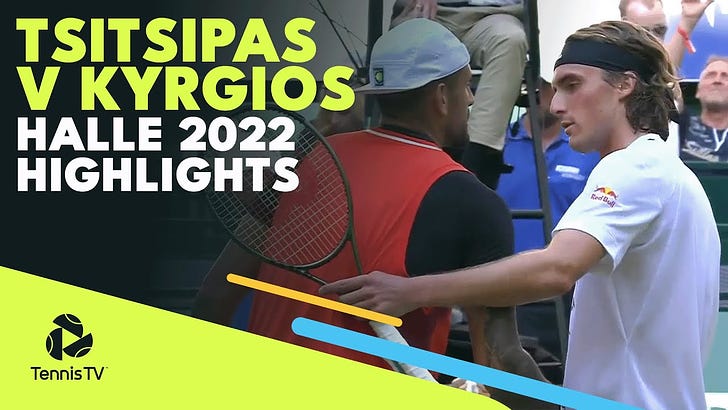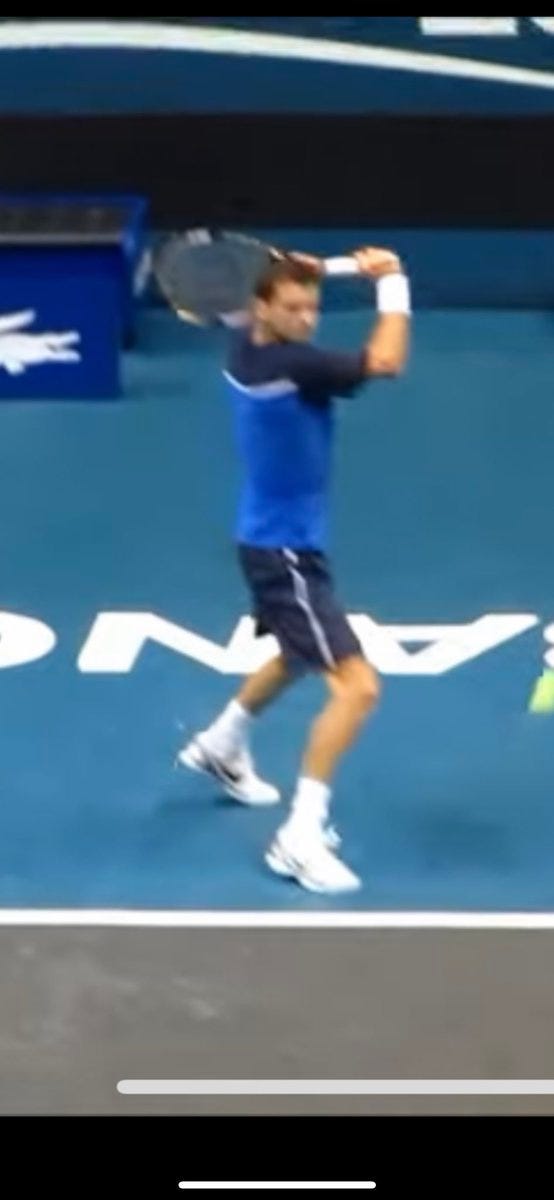Nick Kyrgios came from a set down to defeat Stefanos Tsitsipas in the 2nd round of Halle 5/7 6/2 6/4 and extend his H2H to 3-1 over the Greek. Despite a limited schedule, Kyrgios’ natural feel for the game has earned him his 4th top-10 win of the season. A look at this match for both players:
Tsitsipas
On grass this is a terrible match-up for Tsitsipas; his weaker backhand defense (which I have touched on numerous times here and here) is magnified against such a big server on a quick surface. Tsitsipas’ slice backhand takeback is very short, leading to slices that both float long and dump in the net, especially when he is moving (such is the case when playing backhand defense). By taking the racquet back further behind the head (like Federer, Evans, and Dimitrov shown in this tweet) energy is stored in the wrist that can generate the necessary racquet head speed to cut the ball with a lot of spin and control.
Technical limitations aside, the Greek came out with a clear game plan to chip returns in play and get into a lot of return points (something Shapovalov has looked to do better at times this season, and something that Wawrinka nearly always does). The tactic almost paid off today, and it remains a key area for Tsitsipas to improve if he wants to climb higher. Here is a breakdown of Tsitsipas’ return decisions and outcomes:

Near the end of the first set, a visibly agitated Kyrgios was starting to crack on big points off the back of Tsitsipas’ slice. The commentators also saw it:
“Tsitsipas’ tennis is stressing him. Lots of balls coming into play, not what he likes on serve.”
Of the 11 points played at 4-5 with Kyrgios serving, Tsitsipas chipped 9 of the returns (making 8 of them) that helped him generate 2 set points.
This version of Tsitsipas—slicing and blocking the backhand side while remaining aggressive with the forehand—is what he needs to be able to consistently bring when the conditions and matchup calls for it; he’s a far more dynamic and dangerous player when he does this, and it helps him to handcuff explosive players into a slower and messier game.

A look at the numbers shows that Tsitsipas had an excellent serving day starting off (Kyrgios isn’t the best of returners, but I think today was definitely more a case of Tsitsipas serving well). One stark difference that I saw between the two was how much better Tsitsipas is with the serve +1 play off his forehand. Many times he would serve and then immediately jump on the return with his elite forehand. Kyrgios doesn’t do this as much, partly because his forehand isn’t quite as good, and until Kyrgios started to fire off some crowd-pleasing trick shots, Tsitsipas looked very comfortable on his service games.

Tsitsipas went away from the slice and chip return in the second set, and I think it allowed Kyrgios back in the match; he was winning service games quickly and building rhythm from the back heading into the third. While Tsitsipas regained his chip return discipline in the third set, his own serve had dropped off from the ridiculous level of set 1—he only made 57% of first serves in sets 2 and 3—and this was enough for Kyrgios to get into Tsitsipas’ service games, generating 10 break points across these two sets.
Kyrgios
Kyrgios seemed more agitated than usual today (which is saying a lot). Complaints about phones, coughs, hawkeye, his box, and time violations all came up. A racquet was smashed, another thrown. Federer once described one of his Kyrgios matches as a ‘circus’, and I think that’s often a fair assessment.
We could talk about the serve, the hands, and the trick shots, but it would fail to accurately capture the player without talking about all the between-point antics. While someone like Bublik plays chaotic points, Kyrgios plays chaotic points and raises chaos between points as well—especially when losing. I don’t think it’s intentional as much as a habit: Kyrgios loses a point, gets emotional, looks to blame something—anything—other than himself, and the circus starts.
Tsitsipas at one point resorted to hitting warm-up serves while Kyrgios demanded to see the supervisor midway through a service game. Like having to adjust to a lefty, playing Kyrgios comes with its own unique challenges, and for all his flaws, I find it fascinating how often he wins big points and matches. Just looking at his baseline serve and return statistics doesn’t do him justice, because, unlike nearly any other player, he has a knack for winning important points. It’s not just a narrative, either, as Tennis Abstract showed in this interesting piece. A quote from that article:
“Most players take advantage in 0-40 situations, and to a lesser extent at break points, but Kyrgios is on another planet. The average player wins roughly 10% more return points in break situations; Kyrgios triples the ratio.”
From a game perspective, Kyrgios applies pressure in some unique ways. Firstly, his stock forehands and backhands produce very different balls. The forehand is heavy and whippy, but the backhand is a flat pancake. Cam Norrie has this feature on his groundstrokes as well, and I think it’s an underappreciated aspect of playing them. On top of this, when facing Kyrgios down break point you have the added pressure of knowing that break point chances on his serve are going to be rare. He is very good at creating discomfort, even before you add in the underhand serves, the slap shots, the tweeners, the rants, and the racquet smashes, and I think that is partly reflected in his ‘clutch’ reputation. However, for all the effectiveness of the chaos, it doesn’t win titles. The best players are too consistent over five sets, and Kyrgios’ refusal to change and mature has robbed him of being a genuine contender at slams.
Kyrgios said this in a recent interview with Ultima Hora when asked about his controversial reputation (emphasis added):
“I’m 27 years old now and I’ve been playing like this since I was ten. I have always been very emotional and ambitious. I’m not going to change. Because I think the fans want to see exciting and intense games. If you lose, you will be angry. It’s normal, it’s human. Some show it more and some less.”
The circus continues on Friday when Kyrgios plays Pablo Carreno Busta in the quarterfinals of Halle.










